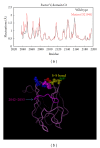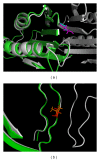Analyzing effects of naturally occurring missense mutations
- PMID: 22577471
- PMCID: PMC3346971
- DOI: 10.1155/2012/805827
Analyzing effects of naturally occurring missense mutations
Abstract
Single-point mutation in genome, for example, single-nucleotide polymorphism (SNP) or rare genetic mutation, is the change of a single nucleotide for another in the genome sequence. Some of them will produce an amino acid substitution in the corresponding protein sequence (missense mutations); others will not. This paper focuses on genetic mutations resulting in a change in the amino acid sequence of the corresponding protein and how to assess their effects on protein wild-type characteristics. The existing methods and approaches for predicting the effects of mutation on protein stability, structure, and dynamics are outlined and discussed with respect to their underlying principles. Available resources, either as stand-alone applications or webservers, are pointed out as well. It is emphasized that understanding the molecular mechanisms behind these effects due to these missense mutations is of critical importance for detecting disease-causing mutations. The paper provides several examples of the application of 3D structure-based methods to model the effects of protein stability and protein-protein interactions caused by missense mutations as well.
Figures




References
-
- Mooney S. Bioinformatics approaches and resources for single nucleotide polymorphism functional analysis. Briefings in Bioinformatics. 2005;6(1):44–56. - PubMed
-
- Hagmann M. Human genome. A good SNP may be hard to find. Science. 1999;285(5424):21–22. - PubMed
-
- Strachan T, Read AP. Human Molecular Genetics . 1999.
Publication types
MeSH terms
Substances
Grants and funding
LinkOut - more resources
Full Text Sources
Other Literature Sources

